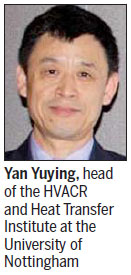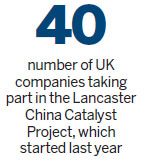Acquiring knowledge, building strength
Updated: 2015-09-05 07:42
By Cecily Liu(China Daily Europe)
|
|||||||||||
Zhuzhou CSR is doing the work at Dynex because the semiconductor technology is at the heart of the drivetrain system, so working with Dynex's existing capability can better deliver cost-effective and well-tailored products for customers, Taylor says.
Another case of synergy is Chongqing Machinery & Electric Co's acquisition of Manchester-based Precision Technologies Group in 2010. Neil Jones, group business development director at Precision Technologies, says the Chongqing company has demonstrated its regard for research and development by allowing it to invest 12 to 15 percent of revenue in R&D.
Technologies Group in 2010. Neil Jones, group business development director at Precision Technologies, says the Chongqing company has demonstrated its regard for research and development by allowing it to invest 12 to 15 percent of revenue in R&D.
"Chongqing Machinery & Electric has realized that R&D is at the heart of what we do today and for the future," he says. "They allow us to invest in R&D to improve our processes, quality and accuracy, which is at the forefront of precision engineering and technology."
Most of the R&D that Precision Technologies does is on advanced machine tools such as the Zenith, a precision helical grinding machine that the company developed through an intensive effort.
The investment has paid off because the machine is significantly better than similar machines sold by competitors, and as a result, Precision Technologies has taken customers away from rivals, Jones says.
Meanwhile, Precision Technologies also works closely with the parent company subsidiary Chongqing Machine Tool Group Co to make compressor rotors for the Chinese market, which involves extensive joint R&D and knowledge sharing.
Often, research and development is crucial for a Chinese company to reap all the benefits of an acquisition, as shown by the Chinese automotive manufacturer SAIC Motor Corp Ltd, which bought technology relating to the Rover 75 and Rover 25 models after the British carmaker MG Rover collapsed in 2005.
To help SAIC fully integrate MG Rover's intellectual property into its own cars, the British consulting firm Ricardo Group offered to provide an R&D center in Britain to train SAIC's engineers.

The center, in the English Midlands, employed about 200 engineers, many of whom were former MG Rover employees. The center was later integrated into SAIC's UK operation.
Mark Garrett, chief operating officer of Ricardo Group, says his company's help in setting up the R&D center enabled the intellectual property that SAIC had bought from MG Rover to be applied quickly to create new products, such as the Roewe 550.
A new automobile with MG technology, Roewe 550 was fully compliant with European Union crash performance standards and was launched in the China market within three years.
In addition, many Chinese companies have set up joint R&D projects with European universities, leveraging the expertise of these universities' researchers. Once new research is developed on campus, the companies take the technology into their own laboratories for product commercialization.
One example is the participation of Huawei in the University of Surrey's 5G Innovation Centre, launched in 2013, as a founding member and industry partner. It is investing 5 million pounds in the center and has provided expertise in and equipment for testing by the center.
Keith Robson, CEO of the center, says as the R&D work focuses on developing a common standard for 5G technology, having an important telecommunications company like Huawei as a member is important because it means Huawei's 5G standards will fit well with the global standard as it develops.
Without a common standard, there is risk of 5G technology fragmentation, meaning that individual industries, such as automotive, financial services, healthcare and telecommunications, wouldn't benefit from the integration of 5G.
Robson says the Huawei equipment is of a quality that only a few companies in the world can deliver.
The Huawei team is now at the University of Surrey helping with a large-scale installation of advanced 4G equipment as part of the innovation center's unique 5G test facility, which will open at the University's Guildford campus in September. Huawei soon will also provide the center some of its 5G equipment, which represents advanced and newly developed technology.
The University of Nottingham is also conducting R&D for electric and hybrid vehicles with Chinese automotive manufacturer FAW Group Corp, focusing on thermal management and improving thermal efficiency.
The thermal management research focuses on keeping the temperature of electric car batteries within a range for optimal operation, which will also improve safety and prolong the lifespan of batteries, says Yan Yuying, a professor of thermofluids engineering and head of the HVACR (heating, ventilating, and air conditioning) and Heat Transfer Institute at the University of Nottingham.
Today's Top News
Acquiring knowledge, building strength
Foreign bears don't affect China - yet
Austria to end messures letting migrants in
Ex-VP nominee Palin: Immigrants in US should 'speak American'
China 2014 GDP growth revised down to 7.3%
White paper on Tibet reaffirms living Buddha policy
Austria, Germany open borders to migrants
PBOC governor says stock market correction roughly in place
Hot Topics
Lunar probe , China growth forecasts, Emission rules get tougher, China seen through 'colored lens', International board,
Editor's Picks

|

|

|

|

|

|






